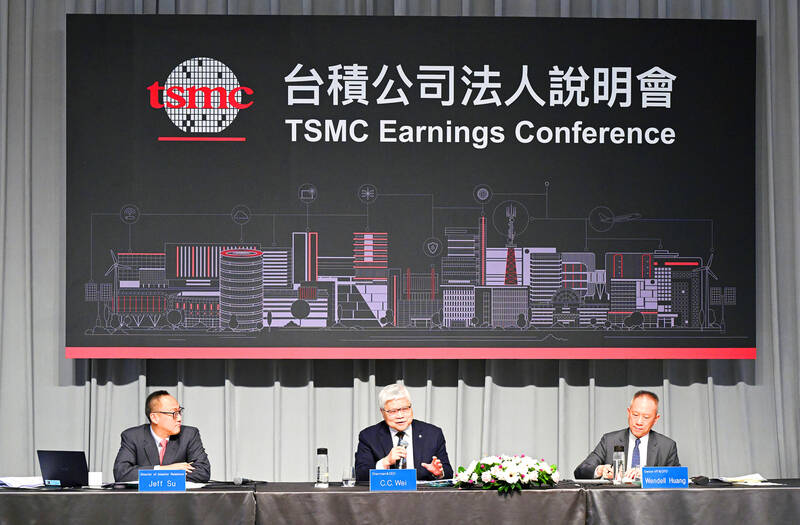Taiwan Semiconductor Manufacturing Co (TSMC, 台積電) yesterday increased its projected revenue growth for this year to above 25 percent, as stronger-than-expected demand for premium smartphones and artificial intelligence (AI) devices are to drive greater utilization of cutting-edge 3-nanometer and 5-nanometer chips.
In April TSMC estimated 21 to 24 percent annual growth.
The firm’s revenue growth is on track to greatly outpace the global foundry industry, which is expected to rise about 10 percent this year.

Photo: Liao Chen-hui, Taipei Times
“Over the past three months, we have observed stronger AI and high-end smartphone demand from our customers, which is to boost the overall capacity utilization for our leading-edge 3-nanometer and 5-nanometer technologies in the second half of 2024,” TSMC chairman and CEO C.C. Wei (魏哲家) told an investors’ conference in Taipei yesterday. “Thus, we continue to expect 2024 to be a strong growth year for TSMC.”
TSMC hiked its capital expenditure budget for this year to between US$30 billion and US$32 billion, compared with an earlier expectation that it would be US$28 billion to US$32 billion.
Up to 80 percent of the new budget would be for advanced process technologies, it said.
TSMC expects 3-nanometer and 5-nanometer capacity to be tight this year and through next year, as most customers are trying to pack their devices with AI functions, Wei said.
Advanced packing capacity would continue to be constrained through next year, even though TSMC plans to more than double its chip-on-wafer-on-substrate capacity next year, he said.
For this quarter, TSMC expects revenue to reach an all-time high, expanding by 7.59 percent to 11.43 percent sequentially to between US$22.4 billion and US$23.2 billion compared with US$20.82 billion last quarter.
About half of TSMC’s revenue last quarter came from 3-nanometer and 5-nanometer chips, which were primarily used in AI applications and high-performance computing devices, it said.
“Moving into the third quarter, we expect our business to be supported by smartphone and AI demand for our leading-edge process technologies,” Wei said.
Gross margin is expected to improve further from 53.2 percent last quarter to between 53.5 percent and 55.5 percent this quarter, largely due to improved factory utilization, TSMC said.
The chipmaker maintained its long-term gross margin target at more than 53 percent, given mounting manufacturing costs, mainly from overseas fabs.
With two new fabs in Arizona and Kumamoto, Japan, to commence operations next year, gross margin would go down by 2 to 3 percentage points, it said.
Regarding former US president Donald Trump’s remarks that Taiwan took chip business from the US, Wei said that TSMC would stand pat on its global expansion strategy with ongoing projects in the US, Japan and Europe.
The chipmaker has no plans to form joint ventures to accelerate overseas capacity expansion, he added.
In the April-to-June quarter, TSMC’s net profit was NT$247.85 billion (US$7.6 billion), up 36.3 percent from NT$181.8 billion a year earlier and 9.9 percent from NT$225.49 billion in the previous quarter.
Earnings per share rose from NT$7.01 a year earlier and NT$8.7 a prior quarter to NT$9.56.
Operating margin rose from 42 percent a year earlier and the previous quarter to 42.5 percent, while operating margin surpassed the chipmaker’s guidance of 40 to 42 percent.

Nvidia Corp chief executive officer Jensen Huang (黃仁勳) on Monday introduced the company’s latest supercomputer platform, featuring six new chips made by Taiwan Semiconductor Manufacturing Co (TSMC, 台積電), saying that it is now “in full production.” “If Vera Rubin is going to be in time for this year, it must be in production by now, and so, today I can tell you that Vera Rubin is in full production,” Huang said during his keynote speech at CES in Las Vegas. The rollout of six concurrent chips for Vera Rubin — the company’s next-generation artificial intelligence (AI) computing platform — marks a strategic

REVENUE PERFORMANCE: Cloud and network products, and electronic components saw strong increases, while smart consumer electronics and computing products fell Hon Hai Precision Industry Co (鴻海精密) yesterday posted 26.51 percent quarterly growth in revenue for last quarter to NT$2.6 trillion (US$82.44 billion), the strongest on record for the period and above expectations, but the company forecast a slight revenue dip this quarter due to seasonal factors. On an annual basis, revenue last quarter grew 22.07 percent, the company said. Analysts on average estimated about NT$2.4 trillion increase. Hon Hai, which assembles servers for Nvidia Corp and iPhones for Apple Inc, is expanding its capacity in the US, adding artificial intelligence (AI) server production in Wisconsin and Texas, where it operates established campuses. This

US President Donald Trump on Friday blocked US photonics firm HieFo Corp’s US$3 million acquisition of assets in New Jersey-based aerospace and defense specialist Emcore Corp, citing national security and China-related concerns. In an order released by the White House, Trump said HieFo was “controlled by a citizen of the People’s Republic of China” and that its 2024 acquisition of Emcore’s businesses led the US president to believe that it might “take action that threatens to impair the national security of the United States.” The order did not name the person or detail Trump’s concerns. “The Transaction is hereby prohibited,”

Garment maker Makalot Industrial Co (聚陽) yesterday reported lower-than-expected fourth-quarter revenue of NT$7.93 billion (US$251.44 million), down 9.48 percent from NT$8.76 billion a year earlier. On a quarterly basis, revenue fell 10.83 percent from NT$8.89 billion, company data showed. The figure was also lower than market expectations of NT$8.05 billion, according to data compiled by Yuanta Securities Investment and Consulting Co (元大投顧), which had projected NT$8.22 billion. Makalot’s revenue this quarter would likely increase by a mid-teens percentage as the industry is entering its high season, Yuanta said. Overall, Makalot’s revenue last year totaled NT$34.43 billion, down 3.08 percent from its record NT$35.52